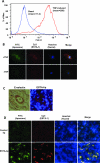Thioaptamer conjugated liposomes for tumor vasculature targeting
- PMID: 21666286
- PMCID: PMC3248173
- DOI: 10.18632/oncotarget.261
Thioaptamer conjugated liposomes for tumor vasculature targeting
Abstract
Recent developments in multi-functional nanoparticles offer a great potential for targeted delivery of therapeutic compounds and imaging contrast agents to specific cell types, in turn, enhancing therapeutic effect and minimizing side effects. Despite the promise, site specific delivery carriers have not been translated into clinical reality. In this study, we have developed long circulating liposomes with the outer surface decorated with thioated oligonucleotide aptamer (thioaptamer) against E-selectin (ESTA) and evaluated the targeting efficacy and PK parameters. In vitro targeting studies using Human Umbilical Cord Vein Endothelial Cell (HUVEC) demonstrated efficient and rapid uptake of the ESTA conjugated liposomes (ESTA-lip). In vivo, the intravenous administration of ESTA-lip resulted in their accumulation at the tumor vasculature of breast tumor xenografts without shortening the circulation half-life. The study presented here represents an exemplary use of thioaptamer and liposome and opens the door to testing various combinations of thioaptamer and nanocarriers that can be constructed to target multiple cancer types and tumor components for delivery of both therapeutics and imaging agent.
Figures


Comment in
-
Is nanomedicine still promising?Oncotarget. 2011 Jun;2(6):430-2. doi: 10.18632/oncotarget.295. Oncotarget. 2011. PMID: 21677362 Free PMC article. No abstract available.
References
-
- Farokhzad OC, Langer R. Impact of nanotechnology on drug delivery. ACS Nano. 2009;3(1):16–20. - PubMed
-
- Ferrari M. Cancer nanotechnology: opportunities and challenges. Nat Rev Cancer. 2005;5(3):161–171. - PubMed
-
- Less JR, Skalak TC, Sevick EM, Jain RK. Microvascular architecture in a mammary carcinoma: branching patterns and vessel dimensions. Cancer Res. 1991;51(1):265–273. - PubMed
Publication types
MeSH terms
Substances
Grants and funding
LinkOut - more resources
Full Text Sources
Other Literature Sources

